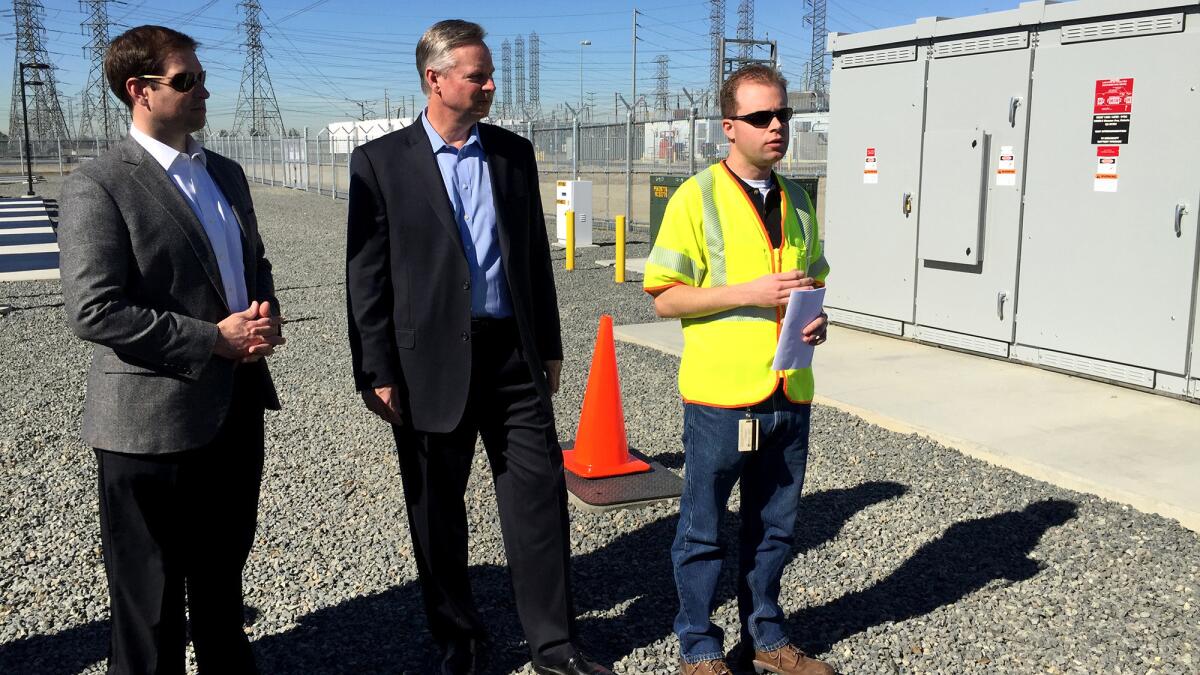Edison and Tesla unveil giant energy storage system

- Share via
Tesla Motors Inc. and Southern California Edison on Monday unveiled one of the world’s largest energy storage facilities, part of a massive deployment of grid-connected batteries that regulators hail as key to helping keep Southern California’s lights on and reducing fossil-fuel reliance.
The facility at the utility’s Mira Loma substation in Ontario contains nearly 400 Tesla PowerPack units on a 1.5-acre site, which can store enough energy to power 2,500 homes for a day or 15,000 homes for four hours. The utility will use the collection of lithium-ion batteries, which look like big white refrigerators, to gather electricity at night and other off-peak hours so that the electrons can be injected back into the grid when power use jumps.
Tesla and Edison sealed the deal on the project in September as part of a state-mandated effort to compensate for the hobbled Aliso Canyon natural gas storage facility. They fired up the batteries in December.
“This was unprecedented fast action,” Michael Picker, president of the California Public Utilities Commission, said at a ribbon-cutting ceremony as part of media events across the region to tout a growing number of energy storage projects.
Picker said advancements in how electricity is delivered are happening at a pace that even his office can’t track. “The innovation taking place occurs faster than we can regulate,” he said.
In addition to the Tesla-Edison project, storage facilities of similar size are being rolled out by San Diego Gas & Electric with AES Energy Storage and by Greensmith Energy Partners with AltaGas. In all, the projects are adding 77.5 megawatts of energy storage to the state’s electricity grid.
Ravi Manghani, director of energy storage for Boston-based GTM Research, said the delivery of the battery systems in a matter of months highlights that energy storage, which continues to drop in price, can be a strong alternative during times of high electricity consumption to natural gas peaker plants, which contribute to pollution. Peaker plants, which are tapped during high-demand periods, can take two to three years to get through the permitting and building process, he said.
The state operates under a mandate to produce 50% of its electricity from clean energy sources such as solar and wind by 2030 and to reduce greenhouse gas emissions to 80% below 1990 levels by 2050.
But the missing ingredient has been energy storage because solar and wind produce electricity only at certain times and there hasn’t been a cost-effective way to retain excess power for times when the sun isn’t shining and the wind isn’t blowing. Storage had been too costly, but experts say the tide is beginning to turn as competition and demand increase.
“As the storage matures and the cost comes down further … more and more products will come online,” Manghani said.
Southern California Edison Chief Executive Kevin Payne said the Tesla project demonstrates the effectiveness of energy storage and the fact that it has become a regular part of the grid.
“It isn’t a pilot project,” Payne said. “This project is part of our vision at Southern California Edison.
“California has been leading the way with aggressive goals,” he said. “Southern California Edison embraces California’s clean energy vision.”
J.B. Straubel, Tesla’s chief technology officer, said his company produced the batteries at its Gigafactory in Nevada, which enabled the rapid deployment at the Mira Loma substation.
“Storage is a piece that’s been missing for the grid for 100 years,” Straubel said. “This wasn’t really at all possible five or 10 years ago. Storage is quite a new thing.”
Tesla’s high-profile chief executive, Elon Musk, didn’t make an appearance at the battery event, but he retweeted the Palo Alto company’s online presentation on the facility, proclaiming “meet the utility grid of the future.”
The projects are a response to mandates by regulators for utilities in Southern California to secure energy storage to compensate for the troubled Aliso Canyon natural gas storage facility, which leaked methane for four months beginning in October 2015. The leak forced thousands of residents in the nearby Porter Ranch community from their homes, complaining about headaches, nosebleeds and other ailments.
The state put a moratorium on injecting gas into Aliso Canyon, although Southern California Gas Co., which owns the facility, tapped some of the remaining gas in the storage field to help meet demand as temperatures dipped last week.
Porter Ranch residents want Aliso Canyon to remain closed. Southern California Gas maintains that the facility is needed to meet ongoing energy demand in the region. Much of Southern California’s electricity comes from power plants that burn natural gas.
“I think we can bring a lot more of this energy storage online,” state Sen. Henry Stern (D-Canoga Park) said during the Tesla-Edison event. “You don’t want one single source that’s too big to fail. I have good news to take home to Porter Ranch.”
Manghani said the delivery of the Tesla and AES storage systems alone can’t make up for a total loss of Aliso Canyon.
“It’s a drop in the bucket,” Manghani said. “You are essentially looking for these sources to come online during the extreme peak.”
For more energy news, follow Ivan Penn on Twitter: @ivanlpenn
UPDATES:
4:45 p.m.: This article was updated with additional analysis and details of other projects.
This article was originally published at 12:50 p.m.
More to Read
Inside the business of entertainment
The Wide Shot brings you news, analysis and insights on everything from streaming wars to production — and what it all means for the future.
You may occasionally receive promotional content from the Los Angeles Times.











